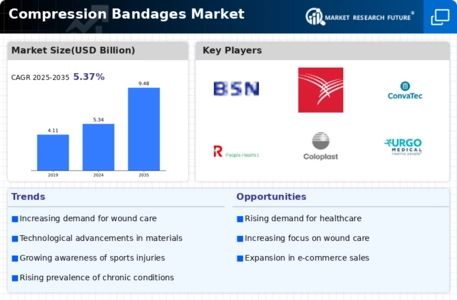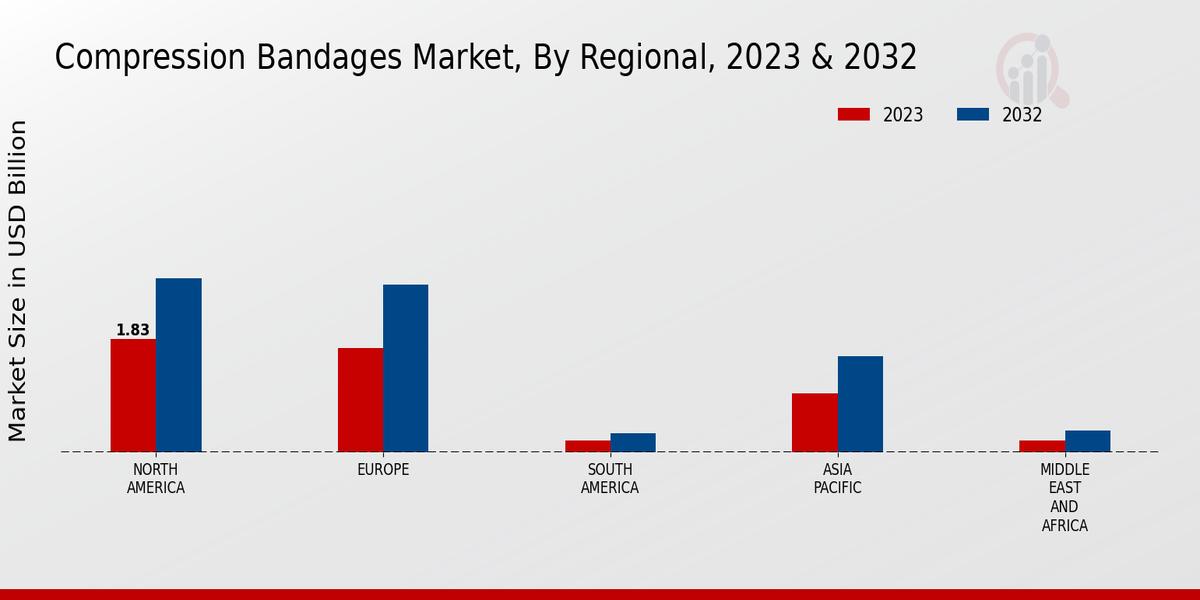Market Growth Projections
The Global Compression Bandages Market Industry is poised for substantial growth, with projections indicating a market value of 5.34 USD Billion in 2024 and an anticipated increase to 9.48 USD Billion by 2035. This growth trajectory reflects a compound annual growth rate of 5.36% from 2025 to 2035. The expansion is driven by various factors, including advancements in technology, rising awareness of preventive healthcare, and the increasing prevalence of chronic wounds. As the market evolves, stakeholders are likely to capitalize on emerging opportunities, positioning themselves strategically to meet the growing demand for compression therapy solutions.
Rising Geriatric Population
The aging population significantly influences the Global Compression Bandages Market Industry. As individuals age, they often experience a higher incidence of circulatory disorders and chronic wounds, necessitating the use of compression bandages for effective management. The demographic shift towards an older population is evident globally, with projections indicating that by 2035, the number of people aged 65 and older will reach unprecedented levels. This demographic trend is expected to drive demand for compression therapy solutions, as healthcare providers increasingly focus on tailored treatments for older patients. The market's growth trajectory is likely to align with this demographic shift.
Advancements in Medical Technology
Technological innovations play a pivotal role in the expansion of the Global Compression Bandages Market Industry. The development of advanced materials and manufacturing techniques has led to the creation of more effective and user-friendly compression bandages. These innovations enhance the therapeutic efficacy of compression therapy, making it a preferred choice among healthcare professionals. For instance, the introduction of elastic and breathable materials has improved patient comfort and compliance. As the market evolves, these advancements are expected to contribute to a projected market value of 9.48 USD Billion by 2035, reflecting a compound annual growth rate of 5.36% from 2025 to 2035.
Rising Incidence of Chronic Wounds
The Global Compression Bandages Market Industry experiences growth due to the increasing prevalence of chronic wounds, such as diabetic ulcers and venous leg ulcers. These conditions necessitate effective wound management solutions, including compression bandages, which promote healing and reduce complications. In 2024, the market is projected to reach 5.34 USD Billion, driven by the need for advanced wound care products. Healthcare providers are increasingly adopting compression therapy as a standard treatment, indicating a shift towards more proactive management of chronic wounds. This trend is likely to continue as the global population ages and the incidence of chronic diseases rises.
Growing Awareness of Preventive Healthcare
The Global Compression Bandages Market Industry benefits from the increasing awareness surrounding preventive healthcare measures. As individuals become more informed about the importance of managing health conditions proactively, the demand for compression bandages rises. This awareness is particularly evident among populations at risk for circulatory issues, where early intervention can prevent severe complications. Educational campaigns and community health initiatives are instrumental in promoting the use of compression therapy. Consequently, this trend is likely to bolster market growth, as more consumers seek effective solutions for maintaining their health and preventing chronic conditions.
Increased Sports Injuries and Rehabilitation Needs
The Global Compression Bandages Market Industry is also propelled by the rising incidence of sports-related injuries and the subsequent need for effective rehabilitation solutions. Athletes and active individuals often require compression bandages to manage swelling and support recovery from injuries. As participation in sports and physical activities continues to grow, so does the demand for compression products. This trend is particularly pronounced in regions with a strong sports culture, where the emphasis on injury prevention and recovery is paramount. The market is expected to respond positively to this demand, further solidifying its position in the healthcare landscape.


















